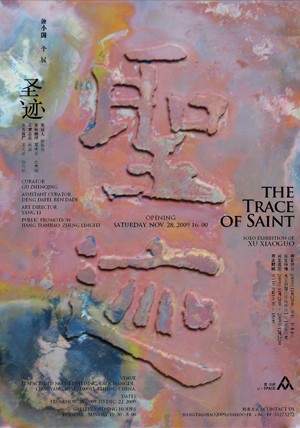In the beginning of the 21st century, the world’s urban population surpassed its rural population. One of the biggest changes that urbanism has brought to the world today is irreversibly transforming people’s visual perception of reality. The development of modernity and social consumption has fostered the huge transformation of human environment from natural to artificial. Most of our sight is veiled by the artificial landscape in and out of cities, and it is now getting harder and harder for anyone to be close to nature. The secularization of literal visual art is no exception: it is getting artificial. No matter whether it is in China, the U.S., or in Europe, the traditional function of literature to convey spirit has been penetrating the history of art. The reality of today’s visual arts is that it is a thin and secular skin of global culture. Xu Xiaoguo realized that the daily visual perceptions had not only interfered with peoples’ lives, but also begun to intervene and control their spirit. For artist Xu Xiaoguo, who expresses through painting, the possibilities of painting’s survival are getting slim after photography and abstract painting arts. The modernity and futurity of painting actually lies in criticism of the current visual arts and the self-evolution of its concepts.
After graduating from Xi’an Academy of Fine Arts, Xu Xiaoguo chose to continue painting. His decision comes was originally based on his familiarity with the technique of painting, but gradually this reasoning was followed by all kinds of problems to confront the painting crisis. Xu Xiaoguo is witnessing this unprecedented crisis in the arts. Painting today seems to just be a way of consuming life for many artists, and only those few who can keep a strong attitude of conceptual exploration can break through and leave their mark.
After his art practices in 2003, Xu Xiaoguo concentrated on searching for concepts and conceptual innovations. Discussion of his methodology always refers to one of the several ways to represent his art. Stage and artificial park landscapes formed the visual presentation of his works during 2005-2007, which actually were a structured framework for fiction and a man-made context for his paintings. The whole shape of his paintings, thus, stands on two parallel concepts of realistic painting and factionary narrative. The structure of Xu Xiaoguo’s painting is similar to “picture-in-picture” mode, as opposed to the centralization of classical composition. In some works, human figures and other objects are put together to tell a story; others use just an empty stage. These man-made landscapes attempt to make up a “reality” out of the real world. Xu Xiaoguo’s seemingly realistic works during 2005-2007 are actually results of his conceptual expression. He realized the representation of the structure of fiction-telling through repetitive description of all kinds of artificial landscapes. If we can say the stages and artificial landscapes are all second-hand and human production is just a special way to express the real world, then Xu Xiaoguo’s representing in his paintings has suitably deprived the complication of the artist’s questioning and thinking about the second-hand reality mode.
Broad reading has made Xu Xiaoguo more and more like a literal artist. Since 2008, Xu Xiaoguo’s conceptual presentation has started to drop its dependence on the narrative frames of visual art and begun to point toward literal background and meanings. He has calmly studied classic images and symbols from the visual heritages of the East and the West. Murra stone, clear land, dragon killing and ghost-searching: these signs point to conflict, negotiation, and reconciliation between humanity and nature. At the same time, the supernatural world has spread into the history of human literature and influenced the way modern people think about history and their collective unconsciousness. Xu Xiaoguo, in his own way, touches and reorganizes those visual fragments, which to him are “self,” or embodiment of the “self” rather than “the others”. He implements his self-recognition, self-identification, and self-criticism during the process of perfecting his paintings; he organizes and structuralizes his experience of criticism and self-criticism though the logic clues of “The Sacred Traces” series.
Xu Xiaoguo does not emphasize individual patterns or artistic styles. His series often jumps from one visual subject to another. This is not only because of his ambition to change, but also relies on his exploration, reference, and conflicts with the artistic issues that concern him. He begins with real problems he has met one by one; then, he filters and criticizes the literal visual system in history and the present in a way of experiencing. Xu Xiaoguo is skilled at using strokes and lines to create strength or conflict, but he never overplays these techniques. Instead, he tends to control himself and control his paintings. He cares more about the expression of his conceptions or views. Sometimes he even consciously makes things more difficult for himself. To build and betray, to rebuild and express, to correct and re-express, his adventure relies on all solutions before a painting is done. Xu Xiaoguo is never afraid of making mistakes, though. In the process of creating or perfecting, he could discard incomplete works without hesitation, even though they sometimes have brought peak experiences. We can conclude that the contents expressed though “The Sacred Traces” series are never complicated or confusing. They are results of a calm progress of narrative and counter-narrative.
Based on his experience criticizing the present literal visual art, Xu Xiaoguo has begun to make metaphors, but now he no longer cares about metaphors or symbols. He has avoided traps of formalism in artistic language and rhetoric. Beginning with searching for the establishment of a point of view, he now does not care about any thoughts or views in his works. Breaking the present literal visual procedures, he does not care about new procedures and the set-up of his own system. What Xu Xiaoguo experiences is a kind of detachment from his paintings and art and an awareness of the human condition.








